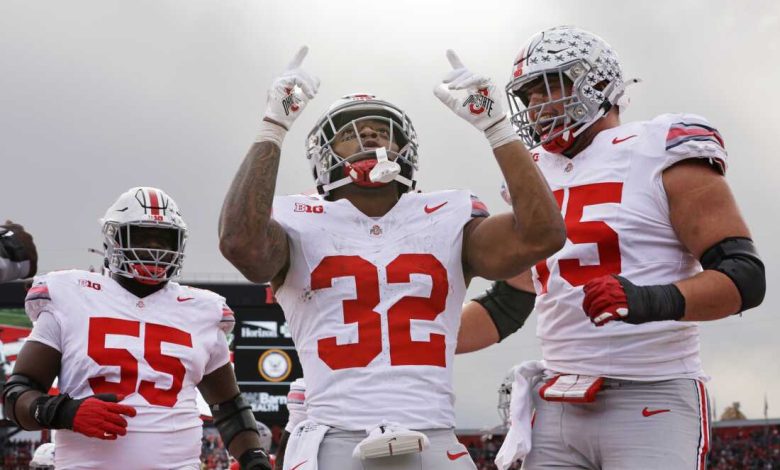Mailbox: Did the religious behavior of Ohio State football players get ‘tiresome’?

In the world of college football, where personalities, performance, and passion collide, few topics have garnered as much attention as the intersection of sports, religion, and public image. Ohio State University, one of the most prestigious and successful football programs in the country, has frequently been in the spotlight, not just for its athletic prowess but also for the religious expressions of its players. Recently, a comment made by a sports columnist about the “tiresome” nature of these religious behaviors sparked a conversation that touches on the role of religion in sports, the boundaries of public expression, and the question of whether it’s possible to overdo something that is so deeply personal.
The comment, made in passing, seemed innocuous to some but left a lingering question in its wake: Are athletes’ religious behaviors — particularly those seen in high-profile programs like Ohio State — starting to wear thin on fans and media alike? What is the role of religion in sports, and can it be seen as a form of “showmanship” rather than sincere belief? Let’s explore this issue in depth and dissect the broader implications of religious expression in the world of college football.
Ohio State Football and Religion: A Longstanding Tradition
Ohio State football has long been associated with excellence and tradition, but it has also been a place where religion has been a significant part of the team’s culture. Players like Chris Spielman, who was known for his on-field tenacity and off-field devoutness, have used their platform to express their faith. More recently, figures like quarterback Justin Fields and defensive back Shaun Wade have been seen publicly engaging in religious activities, including praying before games, expressing gratitude in post-game interviews, and thanking God for their success.
For some, these public displays of religion are seen as genuine reflections of the players’ personal faith, something that should be respected. After all, athletes, like anyone else, have the right to practice their beliefs in the way they see fit, especially when they’re in a high-profile position where their every move is scrutinized. For others, however, there can be a sense that these displays are becoming repetitive or even performative. Is it possible for something as deeply personal as religion to become part of a team’s “brand”? And when does the line blur between sincere religious expression and what might be perceived as self-promotion or pandering?
The ‘Tiresome’ Comment: An Introduction to the Debate
The recent comment about the religious behavior of Ohio State football players being “tiresome” came from a columnist who argued that the repeated displays of faith, especially in the context of the team’s success, detracted from the purity of the sport. The columnist, who was reacting to the constant references to God and prayers before, during, and after games, suggested that it had reached a point where these displays were becoming less about personal faith and more about building a narrative around the team.
To some, the comment felt like a critique of the players’ genuine religious beliefs. After all, how could faith — something deeply personal and meaningful — become tiresome? To others, the columnist’s frustration was understandable. In a world where media narratives often clash with the sincerity of individual beliefs, it’s not difficult to see why someone might view the constant religious references as a distraction from the game itself. But where does one draw the line between respecting religious freedom and questioning the intentions behind the public display of faith?
Religion as a Personal Expression vs. Public Display
To answer this question, it’s essential to first look at the nature of religious expression in sports. At its core, religion is a deeply personal experience. For many athletes, their faith is a central part of their identity and motivation. In the world of college football, where success and failure are often dictated by split-second decisions and high-pressure situations, the idea of relying on a higher power can provide comfort, focus, and resilience.
Public displays of faith are also not unique to Ohio State football. Across the college football landscape, players routinely make signs of the cross, bow their heads for prayers, or wear religious symbols. Some even go so far as to quote Bible verses in post-game interviews. These displays are often seen as a way to acknowledge the role of faith in their lives and to give thanks for their success.
But when religion becomes part of a team’s public identity, there are complications. The media, fans, and even fellow players are exposed to these religious practices, and the question arises: Is it still about faith, or has it become part of the team’s “brand”? A football team is, at its heart, a team. It’s about collective achievement, teamwork, and strategy. But when individual players repeatedly reference their faith in the context of the team’s performance, does it risk turning into a spectacle or a marketing tool? Is it possible for religion to start feeling like part of a carefully cultivated persona rather than an authentic personal expression?
This is where the debate around the “tiresome” nature of religious expression in sports becomes complicated. While some fans appreciate the public displays of faith as a sign of humility and gratitude, others might view it as something that distracts from the game. The potential for overexposure exists — especially in high-profile programs like Ohio State, where success brings constant media coverage. When religion becomes ubiquitous in this context, it’s understandable why some might begin to feel fatigued by its omnipresence.
Religious Freedom in College Athletics
Another key issue to consider is the broader conversation about religious freedom in college athletics. College athletes are often under immense pressure to perform and are subject to the expectations of coaches, fans, and media. In this context, athletes may feel a sense of responsibility to publicly express their faith, especially if it’s a central part of their lives. The NCAA has policies in place to protect the rights of student-athletes, including the right to religious expression. The issue, however, arises when that expression might clash with the broader goals of the team or alienate people who don’t share the same beliefs.
For many players, expressing their faith publicly isn’t just a way of giving thanks; it’s a way of asserting their identity and grounding themselves amid the chaos of college sports. And while it may be tiresome to some, for others it represents authenticity and a sense of purpose beyond the game. It’s also important to note that Ohio State, as a state institution, has a duty to allow students the freedom to express their beliefs in a way that feels genuine to them.
Nevertheless, some critics argue that religion, like any other personal belief, should be expressed in a way that doesn’t dominate the public narrative. This includes maintaining a balance between personal beliefs and the entertainment aspect of sports. College football is a business, and public displays of religion can occasionally feel like a strategic tool to build a certain narrative. Whether or not this is the case in Ohio State football specifically is up for debate, but it raises a valid concern: Should players be conscious of how their public displays of religion are perceived, particularly when they have a large fanbase?
The Role of Religion in the Broader College Football Landscape
The question of whether religious behavior in college football has become “tiresome” also speaks to a larger trend within the sport. College football has always been about tradition — and traditions are often tied to ritualistic behaviors, whether they involve prayers, superstitions, or iconic pre-game rituals. Over time, these behaviors evolve, and the line between authenticity and performance becomes blurred.
For some teams, religious rituals are woven into the fabric of their culture. The University of Alabama, for example, has had players routinely pray before games, much like Ohio State, and for many, this is seen as a way to center the mind and focus on the task at hand. Yet, there is often a fine line between celebrating one’s faith and making it the focal point of the entire game. When teams like Ohio State routinely focus on religious elements in their post-game interviews, it can sometimes seem as though the narrative has shifted from athletic achievement to divine intervention — a theme that many people find tiring or overly melodramatic.
At the same time, the intersection of religion and sports can be seen as a positive force. It gives athletes a way to connect with something larger than themselves, provides them with a sense of peace, and helps them cope with the immense pressures of their role. There are many athletes who attribute their success to their faith, and this is something that is deeply meaningful to them. For these athletes, faith is not simply a pre-game ritual — it’s a lifelong journey that shapes their identity.
The Balance Between Faith and Performance
So, did the religious behavior of Ohio State football players get “tiresome”? The answer is likely nuanced. For some fans and media, the constant religious references might feel repetitive or even performative, detracting from the athletic performance itself. For others, these displays are seen as a sign of authenticity, humility, and gratitude, which reflect the personal lives of the players and provide a deeper narrative to the game.
At the end of the day, religion in sports is deeply personal, and athletes should have the freedom to express their beliefs as they see fit. The challenge lies in maintaining a balance between genuine religious expression and the risk of turning it into a spectacle. College football, like any sport, thrives on passion, intensity, and personal identity. For Ohio State, this passion is undoubtedly fueled by their faith, and while it may not be for everyone, it’s important to remember that, at its core, religion is about meaning — and if these displays are meaningful to the players, then that’s something worth respecting.
In a sport that is often more about spectacle than sincerity, the question of authenticity is always up for debate. What matters most, however, is the players’ right to express themselves, and whether fans and media choose to accept or critique that expression should not overshadow the essence of the game itself.









